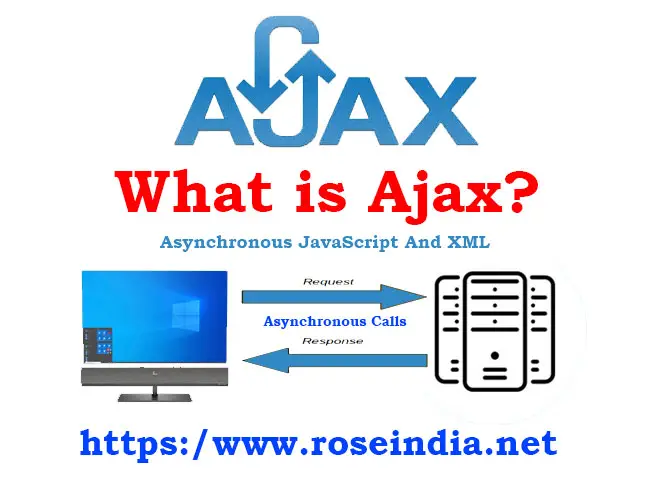Ajax Technologies - What is Ajax? What are Ajax benefits?
In this we are going to introduce you with the highly popular JavaScript framework used in dynamic web applications development. We will introduced you with the Ajax, which is very popular among web application developers. If you are web developers then you should must learn JavaScript and Ajax, these technologies will help in making dynamic web applications.
What is Ajax?
Ajax is not a library or programming language but a concept that uses JavaScript library for creating responsive web applications. In a nutshell, you define an Ajax request, which is sent to a specific server using Ajax. It is that server's job to process the request and provide to the client the results. In a nutshell, Ajax is a great way to get the same effect as a WebSocket, but in a web browser. The Ajax is a concept in web programming which uses JavaScript library to interact with the back-end web servers to get, post, update and delete data using the appropriate http calls. Here you don't have to refresh the complete web page to interact with the web server. For Gmail from Google displays the email to you without complete refresh of the web page. These days developers are using Ajax for creating highly responsive web applications.

What are the advantages of Ajax over WebSockets?
Websocket has no security feature to use. You can send HTML from the WebSocket address to the server using the "setInterval" or "send" options. This means you can control when the request gets done and the response can be as simple as "I got data!". A single "load" event of the client/server allows you to send data of your choice.
Since Ajax uses the browser as a relay station, every Javascript library must handle all the client side processing. The result is a small page with HTML that can be inserted anywhere you like.
Ajax is a great way to load dynamically generated HTML.
What are the downsides of Ajax?
WebSockets are not really supported in JavaScript. You cannot directly do
everything Ajax does with WebSockets.
Ajax is not exactly "XML/RPC", you must provide XMLHttpRequest calls in your
Ajax code if you want to use a web socket connection.
You can use Ajax in combination with CSS3 properties, which adds a bit more
complexity. If you have a huge Ajax task you should do it the way CSS3 allows.
Ajax is a great way to create WebSockets without any JavaScript required. You
don't even have to know HTML!
Do you know about W3C XML1.0?
By its nature XML is very flexible because all elements of the document are
parsed from a large corpus of documents. This means you can create extremely
fast applications in relatively few bytes of memory. You can also write very
nice and scalable CSS, that can be used on any web page.
What is the XMLHttpRequest object?
The XMLHttpRequest object allows the requesting web server to send files over
the wire, so that you can load all the files you wish with their HTML headers.
The request is wrapped in an Ajax request object which contains a list of
headers, such as content-type, encoding, etc. Once the client receives the
requested documents, the request is handled by the server and the entire request
is processed by the browser. This is very much like WebSockets. Both WebSockets
and XMLHttpRequests are very much the same!
Why should I use Ajax?
As mentioned above Ajax is a set of programming concepts in web application development which is used for making asynchronous call to the server-side script from web browser. The Ajax uses JavaScript for making a call to server-side script from web browser. In traditional web applications you have to submit the form to send data to server-side script, but Ajax allows you to send or receive data from server without complete page refresh. This makes the development of web applications that interacts with the server without page refresh. There are many ways developers are using various Ajax frameworks for developing their dynamic web applications.
What are the benefits of Ajax?
Now let's discuss the benefits of Ajax in web application programming. Ajax technologies helps in interacting with the server-side application without web page refresh and its very useful in development of modern web applications. Here are the benefits of using Ajax:
Callback support:
Ajax supports the callback methods while interacting with the server-side applications. In the callback methods you can write your JavaScript code to handle the response generated from server-side applications. For example if you are using Ajax for login to the website then the callback methods will either return success or any other message. If it returns success then you can allow user users to login to your website. If the callback methods returns the error then you can display appropriate message to the user of your website.
Support for Asynchronous calls:
The Asynchronous calls are the calls made to the server-side script in background without freezing the browser application. This way you will able to make call to your server-side applications without stopping the user during the call. These way web developers can make interactive web application for your client.
Responsive Application Development:
Ajax helps in developing responsive web applications as it provides the support for calling server-side script without page refresh. There are many libraries available in JavaScript for easy development of responsive applications. It helps developers in developing user-friendly dynamic applications for web.
Fast and responsive web applications:
There many JavaScript for development of Ajax applications, which helps in development of fast, responsive and light weight web-applications. The JSON standard is used in Ajax based applications for further ease the development of web-applications.
Web developers should learn Ajax frameworks in the year 2021 and beyond for getting better jobs in the IT industry.
Related Ajax Tutorials
If you want to learn Ajax from beginning the check following tutorials:
